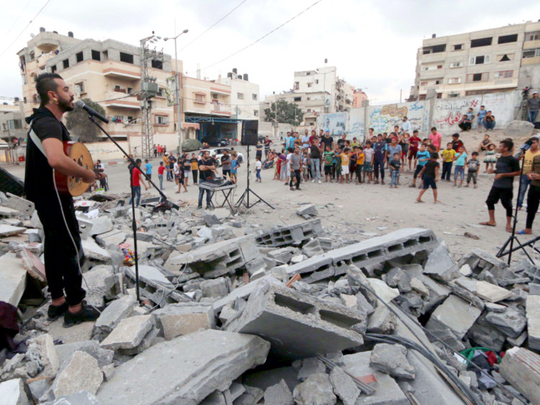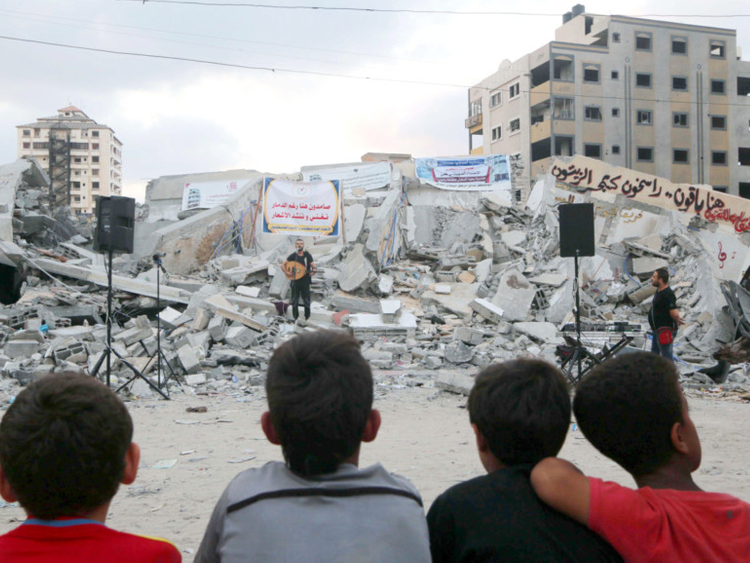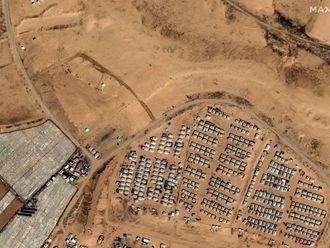
Gaza/Occupied Jerusalem: It was the deep panic of the last-minute rush known to everyone involved in theatre.
One of the playhouse’s top directors, a precocious 27-year-old who had been working in theatre since he was a teenager, was preparing his latest production - a dark comedy. Stage crew and actors had been working for months, all leading up to the Eid Al Adha performance.
The show was to be held in Gaza City’s premier auditorium, the Said Al Mishal Cultural Centre, where the audience could relax into red fabric seats for a night of escapism. On August 9, the show’s final decorations were being hoisted.
Outside, in the early evening sun, people in the Mediterranean city was winding down for the weekend. Many were hoping for an end to a 24-hour flare-up in violence with the Israeli occupation regime.
The Palestinian director, Idrees Taleb, was focused on the preparations for the play, not on the jets in the skies. His office had been on the fourth floor of Al Mishal for half a decade, and he saw no reason why the Israeli occupation military would bomb a theatre.
“During wars, I would leave my house and sleep at the building,” he says. “I always thought it’s the safest place in the world.”
Not long after Taleb left for the day, residents in the area received alerts from the Israeli occupation regime that the building would be hit. The army will phone locals and tell them to get back. In this case, Israeli occupation forces also fired shots at the building. Palestinians in Gaza have become used to these warning shots - they call them “knocks”.
Two hours later, larger munitions transformed Al Mishal into dust, crumbled concrete and twisted steel. At least 18 people were wounded in the attack, Gaza’s ministry of health said.
The razing of the cultural landmark, which held a library and offices for artistic associations including dance troupes and musicians, has shaken the strip’s creative community and rippled out to their supporters worldwide. Founded in 2004 and named after Said Al Mishal, a Palestinian businessman, politician and contemporary of Palestinian president Mahmoud Abbas, the building housed a recreation centre for children affected by the three wars waged between Israel and Hamas during the last decade. Its cafe had buzzed with dancers, actors and artists.
“Al Mishal wasn’t just an office for us; it was a story of love and inspiration. All of our work was there; we lived there; our memories were there,” says Taleb. “I gave my colleagues some hope that a change would happen, but I don’t know what I can say to them after the destruction of our place.”
Earlier this month, some of Britain’s leading dramatists and directors lambasted the bombing, calling it “a devastating loss for the already isolated community” and the flattening of “one of the few large venues for theatre and music performances in besieged Gaza”.
In a letter to the Guardian, 14 major figures from UK theatre, including the director of the National Theatre, Rufus Norris, and playwright Caryl Churchill, condemned the “total destruction” of the five-storey centre. “We support our dear friends and colleagues who describe their great rage and deep pain at the obliteration of this symbol of Palestinian culture and identity,” they said.
Elyse Dodgson, international director at the Royal Court, instigated the letter and said that all signatories had worked with Palestinian artists over the last two decades. She had held workshops in the occupied West Bank, part of the Palestinian territories disconnected from Gaza, and had attempted several times to get permission for writers in Gaza to travel there.
But as an isolated 140-square mile coastal enclave, Gaza is one of the most inaccessible places on Earth as Israel and Egypt maintain a punishing blockade that limits freedom of movement. Many people there have never left, not even to the West Bank - at its narrowest point just 20 miles away.
“Over the course of the three workshops, we applied several times for the four writers to travel, and each time they were refused by the Israeli [occupation] authorities,” says Dodgson. Separately, the Royal Court had attempted to give a residency to Gaza-based artist Nahil Mohana in London, but her visa was refused three times by UK authorities. Finally, the Royal Court decided to make a short film about the process of working with a playwright whom the director cannot meet in person.
Another British-Palestinian performance based at Al Mishal, At Home in Gaza and London, navigated around the blockade by virtually connecting people in both places via a series of simultaneous performances using live-streamed video feeds on big screens.
Based in the UK, co-directors Taghrid Choucair-Vizoso and Julian Maynard Smith had never set foot inside Al Mishal but knew the building intimately. They spent months working and rehearsing with their Gaza-based colleagues, but through live video projection into each other’s studios, even as they were separated by 2,000 miles. The centre was so popular in Gaza that their most recent performance had a date clash and had to be held at another theatre.
Choucair-Vizoso says Al Mishal had a unique work ethic, with rehearsals held with open doors so other artists, musicians and performers could walk in at any time. “We remember it being odd because here you have a rehearsal room and it’s quite private. People don’t just randomly come in and out. And it’s different there. It is a different way of working.”
Jonathan Chadwick, artistic director of UK-based Az Theatre has been leading a campaign for the reconstruction of the theatre, raising close to GBP3,000 during the past couple of weeks. Yet even with money, there are building difficulties due to the ongoing blockade, in which fuel and construction materials are regularly restricted.
Chadwick had worked with an alternative stage group in Gaza called Theatre for Everybody , who performed War and Peace, adapted from Tolstoy’s novel and translated into Arabic, showing to hundreds at Al Mishal in 10 performances throughout 2015.
“For people there in the artistic community and in Gaza society as a whole, [the bombing] was a major and exceptional blow,” Chadwick says.
Unless a building has been taken over for military use, the intentional targeting of cultural property is illegal under international law. The Israeli regime is party to the 1954 Hague Convention , an agreement signed after the massive destruction of cultural heritage during the second world war, and has its own regulations drafted to protect “sensitive sites”, including cultural property, hospitals, schools and power stations.
On the day of the bombing, the occupation army released a statement that did not mention the culture centre, but said jets had targeted a structure it claimed was Hamas.
Responding to a request for comment for this story, the regime’s army said it still considered the structure to have been used by Hamas but was aware that it “was also used for civilian purposes, including a cultural centre, and this fact was taken into account during the attack planning process”.
Sameer Al Mishal, director general of the centre and a relative of its benefactor, balked at the idea of a Hamas presence inside the centre, where around 1,500 people work and volunteer. Since its opening, the building has been a bulwark of freedom of expression and progressive thinking, he said, which had landed its staff in trouble with Hamas’s strict ideology.
In 2007, the local Hamas branch cancelled its licence and Al Mishal could not reopen until 2009. “We’ve faced much hassle from police and interference in the plays and performances. Personally, I was interrogated by Hamas; once I was arrested for three days,” he says.
The occupation regime released a photo of the building with a dotted red line drawn around part of the first floor. Al Mishal said this was a dressing room area behind the stage. That Hamas would set up there was “not logical,” he says. “We were challenging their rules.”
In a statement, the Palestinian Performing Arts Network accused the Israeli occupation military of deliberately targeting Palestinian culture. “The centre was a symbol of Palestinian cultural heritage and was purposefully targeted by the Israeli occupation [forces] because art and culture reinforce and strengthen Palestinian national and cultural identity,” it claimed.
Some residents in Gaza privately suggest a third possibility - that the building was mistaken for another Hamas internal security office in the same area.
For Mohammad Obaid, Al Mishal was a second home. The 28-year-old helped run Al Anqa’a (the Phoenix), a troupe that taught traditional Arab Dabke dancing .
“We wanted to sustain Palestinian folklore,” he says. The group lost all their equipment, costumes and a place to train around 250 children who attend programmes during the summer holiday period.
A day after the bombing, the group joined hundreds of others to perform in the rubble of the building as a show of strength and solidarity. But even that is fading. “Our memories have vanished now. I don’t know if we can create new ones,” says Obaid. “We will try again, but I am not sure if I can convince my colleagues to continue.”
-Guardian News & Media Ltd, 2018













